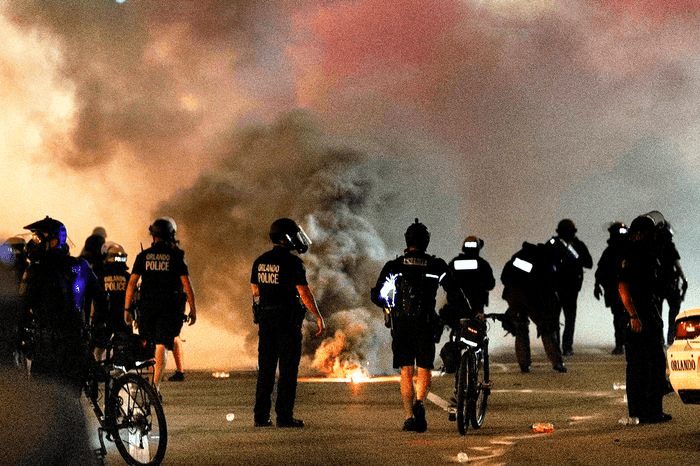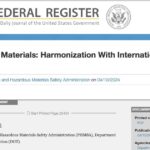Originally published on The CUT

As thousands of protesters across the country have gathered night after night to demand justice for George Floyd and other victims of police brutality, police officers have resorted to a number of violent tactics to shut down otherwise peaceful protests. Widely shared social media posts show police officers aggressively shoving protesters to the ground and ruthlessly beating demonstrators with batons.To disperse protesters, police have also used tear gas, a chemical weapon that’s banned in war — but is technically legal for law enforcement to use during demonstrations. Over the past few days, police have deployed the chemical in Dallas, Los Angeles, New York City, Minneapolis, and even cities with significantly smaller gatherings. In Indiana, a 21-year-old man lost his eye after he was struck in the face with a canister of tear gas.
Why is law enforcement permitted to use such a dangerous weapon on civilians? And what are the implications of using tear gas amid the current pandemic, when a virus is circulating that affects the respiratory system? Here’s what to know about the police’s use of tear gas.
A brief history of tear gas.
The use of tear gas dates back to World War I when soldiers used it during wartime to incapacitate enemy troops. In 1925, the Geneva Convention categorizedtear gas as a chemical warfare agent and banned its use during wartime. However, its use by police in the U.S. is still technically legal. In the 1990s, after the Cold War accelerated the development and stockpiling of chemical weapons, there was international pressure to ban law enforcement from using the agent, Public Radio International reports.However, some countries argued that if police couldn’t use tear gas, they’d be forced to resort to more lethal weapons to quell uprisings. At the 1993 Chemical Weapons Convention, countries came to the compromise that law enforcement could continue to use tear gas to disperse riots.Today, the chemical agent is most commonly used by police at demonstrations, though the ACLU has also documented Border Patrol agents using it against families and children seeking asylum.
When deployed, tear gas causes your eyes to burn and produce tears, and makes breathing extremely painful and difficult. Describing the sensation to ProPublica, one woman said, “I felt like I was choking to death.” And it’s intended to hurt. To create the chemical weapon, most law enforcement agents in the U.S. use a chemical called 2-chlorobenzalmalononitrile, or CS for short. The compound activates the same pain receptor that gets triggered by eating wasabi, Sven-Eric Jordt, a professor of anesthesiology at Duke University, told ProPublica. Imagine the burn from eating wasabi — the pain from CS can be up to 100,000 times more intense, Jordt said.
Police have been freely deploying it during ongoing protests against brutality.
Amid the recent protestsagainst police violence, law enforcement across the country has used tear gas as a form of crowd control, even at gatherings that were overwhelmingly peaceful. In a particularly egregious case, on Monday,law enforcement in Washington, D.C., deployed a copious amount of tear gas to forcefully disperse peaceful protesters outside of the White House so that President Trump could cross the street to take a photo at a nearby church. Trump later claimed that police “didn’t use tear gas,” and the U.S. Park Police also denied having used tear gas on protesters, despite extensive video footage of terrified protesters fleeing from flash grenades and billowing clouds of gas. The police later acknowledged they deployed a pepper compound, which the CDC lists as a form of tear gas, and local reporters have shared photos of tear gas canisters they reportedly found outside the White House.
That police are deploying tear gas amid the coronavirus pandemic is particularly alarming.
In response to the widespread use of tear gas by law enforcement, public-health experts have warnedthat the chemical weapon may intensify the coronavirus pandemic. According to the New York Times, there are two main reasons for concern. First, people typically cough when they encounter tear gas, which produces respiratory droplets, increasing the risk of spreading the virus. Additionally, tear gas can cause long-term lung damage, which may make individuals more susceptible to respiratory illnesses like coronavirus.
Speaking to the widespread use of tear gas, Jordt told the Times, “I’m really concerned that this might catalyze a new wave of COVID-19.”
Some cities are discussing bans.
Across the country, local officials are considering banning the use of tear gas to disperse protests. During a Portland City Council meeting on Wednesday, City Commissioner Chloe Eudaly shared that she “went to bed in tears watching police fire gas canisters as they were rolling down streets into random crowds of protesters,” and suggested the city consider a ban. “It is sadistic to be using tear gas in the middle of a public-health crisis that is attacking people’s respiratory systems,” she said. Meanwhile, Massachusetts state representative Mike Connolly wrote on Twitter that his office is drafting legislation to ban its use on demonstrators, and New Orleans councilman Jay Banks is proposing a similar measure.










